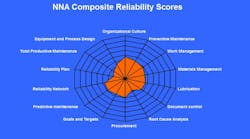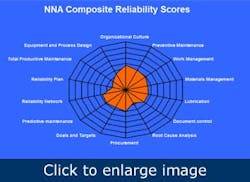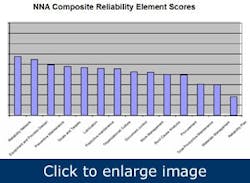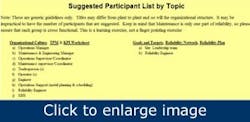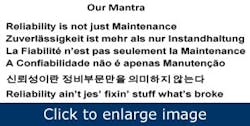In brief:
- Novelis’ Facilitated Self Assessment is used to evaluate where a plant ranks with respect to its reliability maturity. The assessment is conducted by plant personnel and facilitated by resources provide throughout the assessment process.
- Novelis uses 14 reliability elements to create its performance pyramid. They include goals and targets, reliability plan, organizational culture, reliability network, document control, preventive maintenance, predictive maintenance, work management, materials management, lubrication, procurement, root cause analysis, equipment and process design, and TPM.
- The individuals who benefited most from the assessment process were the corporate reliability team, which was grounded on the diverse aspects of reliability and built their credibility with the plant personnel.
Novelis is an organization specializing in aluminum rolled products and aluminum can recycling. The company operates in 11 countries, has nearly 11,000 employees and reported revenue of $10.6 billion in fiscal year 2011. Novelis supplies premium aluminum sheet and foil products to automotive, transportation, packaging, construction, industrial, electronics and printing markets.
The Novelis Facilitated Self Assessment is a tool to evaluate where a specific plant ranks with respect to its reliability maturity. The assessment is conducted by the plant personnel themselves, and it’s facilitated with the assistance that corporate resources provide throughout the assessment process.
Assessment philosophy
The Facilitated Self Assessment is, first and foremost, a learning tool, designed to help plant personnel understand reliability concepts and the plant culture. The assessment belongs to the plant, not to the enterprise. It is expected that, by the end of the process, the plants arrive at a good understanding of their existing level of performance; identify any gaps between that performance and the ideal; and develop a roadmap to bridge those gaps.
A commitment is made to each plant manager that the results of the assessments will not be shared with anyone without their consent. Novelis wants to ensure the plants assess themselves honestly, and the best way of doing that is to ensure the assessment results aren’t used out of context for the purposes of comparison among plants. And, based on the results of the first round of assessments, honesty was obviously not a problem.
The Assessment
In its current form, the assessment is made up of about 400 questions. In turn, each question offers a rating system for answers ranging a regressive or reactive organization to world-class activities.
The combination of questions with a range of answers serves two purposes: assess the plant and provide an endless number of learning opportunities. The assessment is designed to be a mix of education, guidance to known best practice and buy-in to the results. The facilitation was done to make sure the plants understood the tool and held everyone to a common understanding of the scoring. The self assessment was to create plant buy-in to the results.
Figure 1. The facilitated self assessments are based on the 14 elements that Novelis has identified.
The foundation for the assessment was built around the 14 Novelis Reliability Elements (Figure 1). Each element has a corresponding tab in an Excel spreadsheet. The bottom of the element pyramid consists of the reliability foundations: goals and targets, reliability plan, organizational culture, reliability network and document control. Reliability foundations are the softer issues that greatly affect how reliable a plant truly is. Having a world class preventive maintenance/predictive maintenance (PM/PdM) program will only get you so far if your organizational culture can’t or is unwilling to support it in the long term. It’s at this level that it’s taught and reinforced that reliability is not just maintenance. Reliability programs that are led by maintenance can only progress so far. Programs that are led by operations and fully supported by maintenance have the potential to move to the highest levels of reliability maturity.
Document control is one of the foundational elements. The corporate reliability team felt document control, which includes drawings, manuals and PLC programs, was fundamental to properly maintaining a safe and reliable facility.
The next level up the pyramid contains the reliability processes: work management, materials management, preventive maintenance, predictive maintenance and lubrication. This is essentially the meat and potatoes of most reliability programs that outlines how equipment is cared for, how work gets done and how spare parts (MRO) are managed. Although a lot of work can readily be initiated to improve these processes, failing to address the foundational elements could limit the overall returns.
Proceeding up the pyramid, the next level contains the elements for maintenance prevention. These are the activities that generally lead to reducing the need to do maintenance. Root cause analysis and equipment and process design have direct links to eliminating maintenance tasks and affecting the inherent reliability of a process or an asset. The link between procurement and maintenance prevention is not as obvious until you consider the impact that procurement practices have on the reliability of an asset. The proper selection of vendors, setting min/max levels, process for substitution and adherence to specifications can greatly affect how well your equipment runs.
At the top of the pyramid is one of the most misunderstood terms in reliability: total productive maintenance (TPM). In his book, “Making Common Sense Common Practice: Models for Manufacturing Excellence,” Ron Moore defines TPM as “a strategy for improving productivity through improved maintenance and related practices.” He outlines the basic pillars of TPM:
- Restoring equipment to like-new condition
- Operator involvement in maintaining equipment
- Improving maintenance efficiency and effectiveness
- Training people to improve their job skills
- Equipment management and maintenance prevention
- Effective use of preventive and predictive maintenance technology.
Assessment sequence of events
Once the assessment was built, the next challenge was to facilitate the self assessment throughout the 11 Novelis North America (NNA) facilities, which are separated both geographically (from Saguenay, Quebec, to Greensboro, Georgia) and technically (from fully integrated aluminum rolling facilities to an aluminum foil packaging plant). Before embarking on this task, Rules of Engagement were set:
- Completion of the assessment is mandatory. In fact, this is the only absolute that was issued by the North American president to the plant managers regarding reliability.
- Reliability Self Assessments belong to the plants, not corporate.
- Reliability is not just maintenance. Cross-functional teams are to be used to answer the assessment questions.
- Build trust and seek understanding. W. Edwards Deming states: “Don’t blame the individual, fix the system for them.”
The task was to assess all 11 North American plants using three corporate reliability subject matter experts (SMEs), led by Joe Park, the North American reliability manager, during a period of about three months. In order to do this, the following sequence of events was developed:
1. Preliminary plant visit — Each plant was visited by one or more members of the corporate reliability team to help set the stage for the assessment and get the commitment from plant leadership. At the time, the corporate reliability team had just been formed, so the site visits served the additional purpose of establishing roles and responsibilities with respect to reliability. This step was crucial to building relationships with the plants and avoiding miscommunication.
2. Issuing the assessment spreadsheet — The assessment consists of an Excel spreadsheet with links to other documents that are meant to outline and showcase industry best practices. Initially, the intent was to send the spreadsheet by email, but, in order to include the attachments and maintain the links, the plants were directed to an online Reliability portal to download all documents.
3. Follow-up conference call — A conference call was held with the leadership teams in each of the plants to ensure:
a. They were able to download the assessment
b. They understood the nature of the assessment
c. The instructions on how to complete the assessment spreadsheet were explained
d. The due date for completion of the assessment was confirmed and the date for the facilitation portion (corporate site visit) was set
4. Elapsed time — The plants were allotted from two weeks to a maximum of one month to complete the assessment.
5. Facilitation: Corporate site visit — The average plant visit consisted of a three-day event with the support of three or four corporate SMEs. For the larger plants, more time and resources were required on site.
a. Day 1 — Shop floor interviews, shadowing, DILO and one-on-one interviews
b. Day 2 —– Review of each element. For these sessions, the plants reconvened the same cross-functional teams that answered the assessment questions initially. The idea was not to review each question individually, but to seek clarification on the questions that scored either very high or very low. In addition, any discrepancies or questions that arose from Day 1 were discussed. These sessions were opportunities for teaching and sharing best practices. During the discussion of each element, the corporate SMEs prepared the closing presentation based on the discussion and input from the cross-functional teams.
c. Day 3 — Continuing the review of each element and conducting the closing presentation. To reinforce the concept that the plant owned the assessment and, more importantly, the findings, the final presentation was conducted by one of the members of the plant being assessed.
6. Building the final report — The final report for the assessment was prepared by the corporate reliability team and delivered to the plant manager within two weeks of the assessment. The report was formatted using the 14 Novelis Reliability Elements. In addition to outlining the self assessment findings, the report provided a score for each element, a summary of all the element scores as well as commentary intended to showcase the best-in-class standard. A spider chart, Pareto chart and color-coded element pyramid were used to showcase the relative scoring of each element (Figure 2).
Figure 2. Spider charts, Pareto charts and color-coded element pyramids were used to showcase each element’s scoring.
7. Assigning a corporate reliability champion — The expectation set upon completion of the assessment and receipt of the report was that the plant would build a reliability roadmap to close any gaps identified. In order to facilitate the creation and execution of the roadmap, each plant was assigned a corporate reliability champion to help coach them through the process. As it turned out, the three SMEs that carried out the assessment transitioned to the roles of coaches, providing consistency to the process.
Successes and setbacks
As with any project, not everything went perfectly. But the overall outcome was successful. So what were the factors that contributed to the success of the process? The first, and probably the most important, was leadership. The top leadership positions within Novelis North America, starting with President Jean-Marc Germain, made it clear that the organization was going to do this properly because it was the right thing to do. It would have been easy for the team to set goals for a quick return on investment (ROI) from the corporate reliability team. Instead, Novelis’ North American president chose a longer-term view of success, allowing the team to build a strong process based on a culture of learning and education of best practices.
[pullquote]This backdrop of education, with an eye toward excellence, provided the ideal environment to develop the Facilitated Self Assessment and the urgency to go into the plants and get it done. Those who benefited most from the entire assessment process were the corporate reliability team. The assessment process grounded the team on all the diverse aspects of reliability, got them to talk the same language and built their credibility with the plant personnel. Under the leadership of Joe Park, corporate reliability manager, and supported by Glenn Delaney and Nick Bowers, corporate reliability champions, the team quickly bonded during the assessment process.
What didn’t go so well? Early on, a few miscommunications occurred with some of the plants. They had misinterpreted the requirement for a cross-functional team to fill out the assessments as meaning the maintenance manager was to fill out the spreadsheet. The cross-functional requirement was meant to ensure consensus after considering all relevant viewpoints. Operations personnel will answer questions regarding the effectiveness of maintenance differently than the people who provide the maintenance. Conversely, maintenance personnel will have different views on equipment ownership than the operators will. We overcame this problem by adding a tab to the spreadsheet that suggested the appropriate attendees for each session (Figure 3).
Figure 3. A tab was added to the spreadsheet suggesting who should attend the assessment sessions.
Some of the program’s criticism was based on the overall length of the assessment. With more than 400 questions, the assessment is a significant undertaking. There really is no way around this, apart from breaking the assessment up into more manageable chunks, and by using cross-functional teams.
Most of the scores went up during the review of the assessments. In fact, the majority of the plants were too hard on themselves, forgetting to take credit for the things they were doing well.
What’s next?
It was clear that the three corporate reliability champions would not be sufficient to support all 11 North American plants. To add to the workload, the success of the assessments in North America was being communicated throughout global operations, creating a demand for assessments worldwide. Novelis also operates plants in Europe, Asia and South America (Figure 4). An army of reliability professionals was needed to operate at local levels and lead plants on the improvement journey. To respond to this need, an internal curriculum for training reliability engineers (REs) was created. The RE curriculum consists of eight weeks of training, which includes four weeks of theory interspersed with four weeks of hands-on application of the theory in the plants. The class size is limited to 25 participants, and the second wave of REs, this time with a decidedly more global representation, now is being trained.
Figure 4. Novelis developed this poster to reinforce the reliability concept in its plants worldwide.
As for the assessment, work is ongoing. It has currently been translated into French, German, Portuguese and Korean. The Facilitated Self Assessment methodology has been adopted by other groups within Manufacturing Excellence (energy, dust abatement, quality) to gain a better understanding of their current levels of maturity. The challenge is to combine these assessments in attempts to reduce duplication and avoid overtaxing the already busy plants. The recommendation is for each plant to be reassessed every two to three years. Any selected areas for improvement identified during the assessment should be assessed promptly to ensure that improvements are brought about. The plants see value in the assessment and continue to offer support and cooperation.
Glenn Delaney, CMRP, is corporate reliability champion at Novelis (www.novelis.com), a producer of rolled aluminum headquartered in Atlanta. Email him at [email protected]. Bill Schlegel is director of manufacturing excellence and technology at Novelis. Schlegel also is past chairman of the Society of Maintenance and Reliability Professionals (SMRP, www.smrp.org). Email him at [email protected]. Delaney will present Reliability Self Assessment — A Journey of Discovery on Oct. 19 at the SMRP Annual Conference in Greensboro, North Carolina. Visit www.smrp.org/conference to register.
